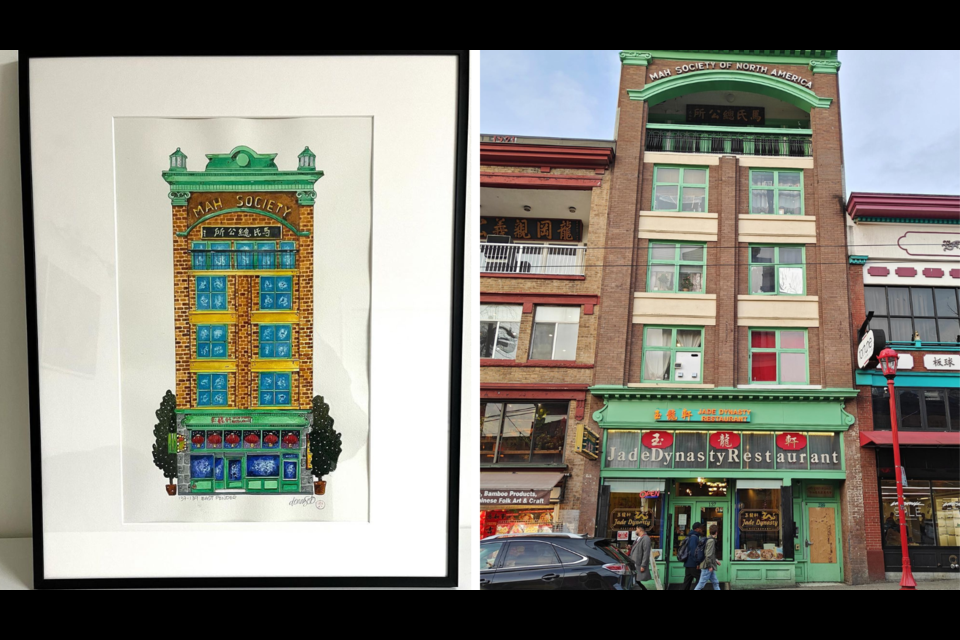Many Vancouverites connect with one artist’s vivid paintings of historic Chinatown buildings because the imagery evokes memories.
Comments on Donna Seto's work range from how they worked or lived in a building decades ago to who they knew from that building to “hey, I was there shopping last week.”
Re-Imagining Chinatown showcases 18 watercolour and ink paintings by Seto which playfully depict Vancouver’s Chinatown, one building at a time. The exhibition is at THIS gallery in the Sun Wah Centre (268 Keefer St) until Feb. 10. Then it will be available for viewing online.
THIS gallery director Shannon Pawliw found Seto on Instagram last year and started following her.
“Seto’s work represents an idealized fiction. It occupies a space that is both cartoonish and nostalgic as it is based on both remembered and factual history," said Pawliw in a media release for the exhibit.
The 18 paintings are part of a set of 50 paintings Seto will complete for a book, expected to be published mid-2025 by House of Anansi. The book will touch upon the last 100 years in Chinatown.
The writer and historian said the book is a result of people’s interest in her paintings and the stories behind them.
'People connected with Chinatown from afar'
When Seto picked up painting again in July 2021 and shared her work on Instagram, an online community slowly formed because they identified with her paintings, pulling out old memories.
With suggestions on which buildings to paint next, the encouraging comments kept Seto going. “People connected with Chinatown from afar," said the artist.
“Chinatown” has meant different things to different people.
For Seto, the Vancouver neighbourhood has meant buying groceries with her parents, eating dim sum, and visiting her grandma who used to live near Oppenheimer Park. (The 104-year-old has since moved out of the neighbourhood and into a facility.)
Her parents, who mainly speak Toisanese and live in Mount Pleasant, still go down to Chinatown all the time.
“They do everything here. See the dentist, pick up the Sing Tao newspaper, their banking," Seto described.
These days, Seto spends more time in Chinatown, connecting with her heritage, supporting local businesses, and getting to know the community.
Locals connect with past and present of buildings in Seto's paintings
When attendee Kelvin Mah heard about Seto’s exhibition, he was intrigued and wanted something for his collection.
He bought the Mah Society/Jade Dynasty 137-139 East Pender painting because his last name is Mah and because he loved the colours in it. To his knowledge, his family wasn’t involved with the clan association.
Instead, his memories of Chinatown were more about his childhood.
As a kid, his parents would do their grocery shopping once or twice a week in the neighbourhood. He recalls the live toads for sale outside of the seafood shop or the dried seahorses in the medicinal herbal shops. “It was the only place you could get it [at the time].”
Today, his connection to Chinatown is more about food, ordering from Chinatown BBQ, New Town Bakery & Restaurant, or Phnom Penh Restaurant.
Though currently running out of wall space, the Vancouver dentist would like to hang the painting in his office.
As time zipped by during the exhibition opening, groups of people consistently flowed in and out, greeting Seto and complimenting her work.
Some learned by word-of-mouth and some heard about it on the radio.
One attendee heard about it from his girlfriend who works with Seto’s sister.
Alvin Pillay found Seto’s work amazing, detailed, and vibrant. His favourite piece is Dollar Meats – 266 East Pender because it’s something “current” and is still standing there to this day.
“It’s amazing the lengths local businesses go to to stay. [Stating] ‘OG still here.’”
Another attendee, Peter Chu, loves Ho Ho Chop Suey/Sun Ah Hotel - 100 East Pender because it’s an iconic restaurant and he used to eat there all the time. He never knew the building had a large vertical sign sticking out on the corner until he saw Seto’s painting.
The restaurant is currently under renovations but Chu looks forward to going to it when it opens back up.
This year brings change to THIS gallery's exhibit formats
Trying something different this year, THIS gallery is having shorter exhibition times, about ten days where the art is physically available to visitors and then, online only.
Pawliw noticed last year that people visited THIS gallery during opening and closing events but rarely on the days in between.
The new format allows her to showcase more artists while drawing the public into the Sun Wah building and “activating” the space more often.
Seto’s paintings are available for purchase with 20 percent of the sales donated to the Vancouver Chinatown Foundation, a local charity focused on physical revitalization, economic revitalization, and cultural revitalization in the neighbourhood.



